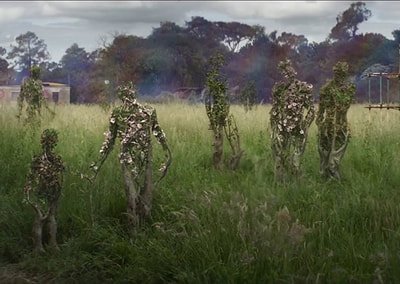What does the end of Annihilation (2018) mean?

Annihilation directed by Alex Garland is an adaptation of the 2014 book by Jeff Vandermeer of the same name. The story centers on Lena, played by Natalie Portman as she and a group of explorers journey into a quarantined area known as “The Shimmer”. One aspect of the film that has led to its fair share of discussion is the meaning of the ending.
Synopsis
The film starts with Lena being interrogated in quarantine. She is probed about how she survived as she managed to survive for months on two weeks of rations. She is then questioned about members of her squad who were missing or dead. We see a meteorite crash into a lighthouse and this area will become a focal point for the film, the center of the Shimmer.
Lena is shown to be a biologist and military veteran and married to another military veteran. She is also shown to have struggled with infidelity with a colleague.
We’re then introduced to “Kane” played by Oscar Isaac her husband who had been missing for over a year. She immediately throws herself into welcoming him back before questioning where he’s been or why he’s been gone for a year.
Kane, notably, is unable to answer anything, even how he managed to get home. Kane then falls ill to the point of needing to be hospitalized.
But before they can reach the hospital, an armed military group stops their ambulance and spirits them away to a virtual black site dubbed, Area X
We’re introduced to the psychologist, Dr. Ventress played by Jennifer Jason Leigh, who serves to introduce “The Shimmer”, a mysterious area that has been spreading for the last 3 years, from the same lighthouse seen at the beginning of the film.
Dr. Ventress also tells Lena that they’ve lost contact with every single team that they’ve sent into “The Shimmer”. Kane is an exception but he is also in a coma.
Lena volunteers to explore the area with the goal of finding something to aid Kane and is subsequently joined by physicist Josie Radek played by Tessa Thompson, a paramedic Anya Thorensen played by Gina Rodriguez, and Cassie “Cass” Pritchard played by Tuva Novotny, and Dr.Ventress.
The team sets off but gets quickly disoriented. They awaken having travelled for days but not remembering any of the details. They observe the various wildlife within “The Shimmer” all of which bares some sign of mutation.
Upon reaching a military base the group finds video logs of the doomed expedition, one features a soldier being cut open only to reveal his organs moving, like a worm or snake-like creature. The group finds his remains covered or perhaps blended with fungi where the footage was recorded.

When night comes, a horrifying creature, dubbed by fans as the Skull Bear, attacks the group and kills Cass. The next day, the group encounters some human-life plants and Anya realizes everyone is likely to mutate. She ties up everyone, vents her concerns, and baits the Skull Bear to attack. She is mauled and killed. Josie manages to kill the beast.
Following this, Ventress flees to the Lighthouse, Josie gives up the fight and becomes one with nature and Lena is left to struggle through it alone. On her journey, she sees what happened to Kane in another video. Notably, she sees his clone as the cameraman to his demise.
Lena finally makes it to the lighthouse where she encounters Ventress, who believes “The Shimmer” will consume everything. She then explodes into a sort of cosmic dust, leaving Lena to face a humanoid automaton that physically dominates her before she tricks it into killing itself in the same way Kane did previously.
She finishes her story and is allowed to leave quarantine. She confirms that the current “Kane” isn’t “really” Kane but he returns the question and she doesn’t answer. They embrace and the film ends.
Analysis

Ambiguous endings have a bit of a bad reputation in film and television. For many in the audience, the desire for closure outweighs almost every other part of the narrative. For example, the ending of Sopranos vs. the ending of Breaking Bad. Both serve their narrative purposes, but while Breaking Bad’s ending is a definite ending and much beloved, the reaction to the ending of the Sopranos was much more mixed which is a risk one takes with ambiguity.
Tying it back to film, while many appreciated the endings of Inception and Blade Runner, fan speculation oftentimes disregards the narrative to focus solely on the importance of the ending when discussion arises.
Annihilation does have an ambiguous ending. But that very ambiguity serves as the crux of the film.
As mentioned before the film centers on the perspective of Lena. She’s the audience’s POV character. We learn about the loss of her husband and her grief more explicitly than any of the other characters and the camera rarely leaves her.
Her grief is a motivator as she has been “unfaithful” to her husband and she blames herself for his death believing him to have taken a suicide mission into The Shimmer. When confronted in the Shimmer, she chooses to fight it. She’s nearly killed until she accepts it, accepts what is happening, and then adapts as necessary to survive.
When returning to Kane it is known both by Lena and the audience that the Kane she is with is not “her” Kane. Not the original man. But on that same note, she’s not “his” Lena. The individuals they were before exploring the shimmer are gone.
The film asks the audience to engage with a metaphor. The Shimmer while being in a literal sense, an alien zone of mystery, also represents a variety of concepts.
The Shimmer as Cancer

The topic of cancer is a recurrent one in the film. Lena starts the film discussing cancer with her students. Ventress is dying of cancer. Cass’s daughter died of Cancer.
The topic of cancer is a difficult one to broach despite its presence in the popular conscious. Cancer’s nature as a corruption of the normal fits “The Shimmer” The various mutations seen within its borders serve as examples of the unrestrained mal-formation of what would be considered normal. “The Shimmer” reconstructs and reconstructs but the creatures it makes are seen as hodgepodges of life at best and corruptions of nature at worst, as seen with the Skull Bear.
“The Shimmer” as an entity doesn’t do this out of malice though. Much like cancer, it just reproduces, endlessly. Its nature is to reproduce whatever enters it.
The Shimmer as “Self Destruction”
The five women who enter “The Shimmer” all come with their own various problems. Ventress is dying of cancer, Josie is a self-harmer, Cass is still grieving the loss of her daughter, Anya is an addict, and Lena feels guilt for her failings as a wife.
When confronted by the nature of “The Shimmer” Cass and Anya meet violent ends, Cass, by random chance, and Anya, by giving into rage. Josie wishes for anything but that and peacefully becomes a plant within “The Shimmer” arguably a suicide and arguably an acceptance of the reality they’re faced with.
Ventress and Lena both soldier on, but between the two of them Ventress is dying and thus views “The Shimmer” as inevitably ending the human race. Making humans inhuman.
Lena, confronted by the automaton, tries to fight it but reaches a level of self-acceptance and an acceptance of death. She destroys herself by mimicking what she saw Kane can do and with that acceptance of destruction, she’s able to escape. The meaning can be, you must learn to accept yourself as you are but also you can argue it is, ego death, the death of oneself, or a sense of self.
Lena does, when asked if she’s really Lena, refuse to answer.
The Shimmer as “Relationships”

One of the more compelling theories as posed by Dan Olson of Folding Ideas, is that “The Shimmer” is representative of the nature of “relations to others”.
Within “The Shimmer” the audience is shown the refractive nature of the area. How it doesn’t necessarily directly copy anything but instead blends elements. In a literal sense, it contains, impossible plants and hybrid animals such as the Shark-Gator and the Skull Bear.
But within “The Shimmer” the audience also sees how people and their connections affect each other. One notable example is the tattoo. We first see it on Anya, in passing. but the film begins to pay more and more attention to it especially when the soldier with the snake insides is on screen and the same tattoo is present. And we see the same tattoo on Lena at the end of the film.
By this, we can see the same instance of people literally leaving their marks on each other. But aside from that it broaches a more philosophical definition of self. For instance, when Kane asks Lena if is she really Lena, is she the same person she was before she left? Yes and no. She may have the same consciousness and memories but physically she has changed. When interacting with others their actions and words serve a similar function as the Shimmer.
It can be seen in groups where members adopt actions to show affiliation, and couples who’ve lived together for a while adapt to each other’s shortcomings both molding and being molded by their partner. Parents are forced to change for their children and children by their parents.
All these serve as cases of “The Other” influencing “The Self” but not necessarily in a negative manner. “The Shimmer” and thus the ending can be read as an acknowledgment of the growth or at least alterations Lena and Kane have made to themselves. The refractions they’ve reflected on to each other.

What do you think? Leave a comment.











The last act was unnecessary scary for me.
ok.
The shimmer seemed more like a natural force of nature, rather than sentient, like the dr describes at the end that it may not even have a want or desire, it seems more like it just is, terrifying as it is beautiful, like an angel.
Thank you for the comment. Any deeper thoughts?
Adam and Eve at the end of the movie.
See the film but then read the books (3 in the trilogy – Book 1 – Annihilation, Book 2 – Authority, Book 3 – Acceptance. Also known as the Southern Reach Trilogy). The film is good, but the books are way better and if you read the books first, the film may be a disappointment to you.
The Cass/bear is absolutely hands down an extremely awesome use of imagination. not only being horrifying the mixture of sounds coming out of it have crept into my mind and surface at the strangest times. it is just wrong on many levels!!!
Reminds me of the aliens from Prey. They were not evil, their aggression was not the result of hostility. The game clearly states that they don’t have mirror neurons. It means they have no empathy. They don’t see anything wrong with what they’re doing. They just multiply by taking over other species.
The scene with the clone is practically non-aggressive. The only blow comes in self-defense.
Watched it originally many years ago… and I’m just now watching it on Netflix…
The Shimmer was the alien equivalent of athlete’s foot fungus.
The meaning of this movie is too pedantic.
Fantastic movie plenty to think about! Yet I felt by the close it was a brilliant example of nihilism! No need to reason it mirrors the world! Existentialists look for a narrative too make sense of the absurd!
Like MIDSOMMAR and other great horror, this tells you about itself from the first frame. The water glasses refract like the shimmer; what you see is familiar, but distorted.
I thought the shimmer was something that wanted to learn and build and mix things together.
If this movie was less confusing, it would be confusing, but less.
I love the water at the end. The reference to the initial drink that kane took was great as this time we have a lot more knowledge on the effects of the shimmer.
All I know is that the person who designed the scene right before we see the chrome alien has definitely taken DMT.
This movie is like an abstract painting that everyone creates their own meaning from. The movie has no actual meaning though, clearly.
I believe the shimmer its an advanced alien technology, its not an organism, it is only a kind of technology that changes the law of physics around it, its not an organism with an objective, it is what it is and acts refracting physics around it and thats why the fire burned those crystal trees without even touching them.. It’s because the fire ínside the thing refracted to the organisms related to this thing.
Like a viral infection. Nothing was intentional.
After watching this movie i’m not the same person. Thanks for the article.
This movie made me question my everything.
My biggest issue with the ending is that when Lena destroys the shimmer clone of herself, it spreads, destroying every aspect OF the shimmer. Shouldn’t that have destroyed any traces of the shimmer infection in Lena?
Especially when you take into account they made a point of mentioning that as soon as the shimmer was destroyed “Kane’s” vitals returned to normal, and he was fine. If he was still connected to the shimmer to that extent, shouldn’t he have disintegrated, too?
And if “Kane” was a manifestation of the Shimmer and not the real Kane, why was his body falling apart and not just some anomalous mutation (even if only on the inside)?
I thought it was made clear that it was the (not fully formed Lena clone) that was killed because it was still mostly “metallic” and just stood there as Lena destroyed it, and didn’t just burst into flames like the original Kane did with the same grenade.
Maybe it’s because I watched it on TV and not the big screen, but i intentionally paid close attention to Lena’s glass of water at the end and didn’t notice any mutation.
I started watching and it seemed too weird… so searching to find more, your post gave me just enough info that this story line was just too ambiguous.
The whole movie is an acid trip.
This movie is fundamentally a story about self-destruction about how humans by our own nature bring ourselves to ruin whether it be drinking, smoking, sabotaging a perfectly healthy relationship by cheating or abusing a substance.
It calls attention to this numerous times with them on the boats talking about how each one of them are broken, in the tower the doctor discusses the nature of humans and that self-destruction.
There’s even examples of just biology destroying itself with cancer, cancer is literally the action of your body tearing itself apart creating tumors and other such things that fundamentally kill you your body destroys itself.
The shimmer is essentially supposed to be a framing device for this idea how humanity fundamentally destroy themselves even the alien in the center of it all in the lighthouse destroys itself by impersonating humans taking the phosphorus grenade.
The novel is really fascinating, I will have to check out the film!
Only got to see this movie the other day at the recommendation of my very smart son. Remembering that this movie was made by the creator of Ex Machina, and taking into account the recurring cancer references throughout the film, I see the alien presence as growth without reason, without conscience, without morals, or even without malevolence. An alien life form completely different from anything we could imagine that feels nothing and wants nothing but to replicate. We’re doomed, but not because anything wants to destroy us; it’s just using us as a matrix to replicate in. A supremely creepy and thought-provoking film that I will come back to more than once. I was sorry it was not more successful at the box office, because it deserved to be on every level.
I just can’t believe that the scientists let them go without knowing that they obviously aliens. Based on the story that they were told .. also because they all had hazmat suits, I assumed that they would check there DNA, and blood work.
Counterpoint, it’s a movie.
Was thinking about something in this movie. They mentioned how its been growing for 3 years and that in 3 months time the research they had set up would be swallowed. They never mention anything about it expanding at an increasing or decreasing rate, just that it is expanding so it will effect people eventually. even if at this point it has expanded 50km after 3 years. That would still imply hundreds of years until it covers Earth but by that time, would we even need to live on Earth?
Sometimes I feel the makers too don’t know what is the meaning of the ending and just want people to create their own theories.
That’s not a bad interpretation.
Cosmic horror is not only the most dreaded of all realities, but also the most realistic… whose to say we wont someday not have the option of escaping being eaten by a black hole? it would be very similar to this intermengeling, just in a hyper instant time, very dreadful
More and more people are saying this.
I think it really was a meteorite from the deep space hitting the Earth merely by chance. The life as we know on Earth may very well be of “extraterrestial” origins by foreign organic matter transported via meteorite. Most likely we will never know for sure, though.
As said in the movie, the “alien” doesn’t actually want anything, “it” has absolutely no agenda at all, it just happens to be there and it just happens to behave the way it behaves naturally. It’s all about perspective, and we mostly see the movie from the perspective of humankind.
From “it’s” perspective, “it” is in a very weird place and simply survives. From our perspective our status quo has been disrupted by something weird, and something that we can not undestand nor explain. And we as humans tend to assume the worst about things we don’t understand, it’s just in out nature and in our survival instincts.
So based on evidence, or more precicely the lack of evidence of the alien entity being malignant or even willing to participate, I think “it” just happened to find it’s way to Earth of all objects on space. On Earth it simply existed and survived = multiplied and created habitable surroundings. Not at all the opposite what us humans will do on foreign planets in the future.
So maybe it was just misfortunate enough to end up in such a hostile environment as Earth and humans. I mean all “it” did was get lost in space, end up in a strange world, and just being “itself” with no agendae. Humans however deliberately attacked and tried to kill (or at least dispose of) it by any means necessary. Perhaps the Earth and humans were the cancer in the cosmos, killing any and all rival or co-existing lifeforms even if it meant annihilating humanity itself in the process?
I think the shimmer was an extension of the alien that landed… It was just beyond our(humans) comprehention of what’s the alien life was doing just by existing.
I believe in the books, its explained to be an alien terraforming device that fell to Earth.
A psychedelic journey, something like consciousness and spiritual balance materialized as “the shimmer”.
The thing that confuses me is if clone kane is at the base, how was there a blob thing there to clone Lena as well if the movie doesn’t establish there’s more than one blob alien thing?? Lena is the original Lena there was no swap but you’re suppose to take it as Lena’s clone is also as much Lena than the og Lena while both are just as much the alien that came from the shimmer.
Why have I never read this article. I’ve rewatched that movie too many times trying to fully understand it.
It just got published.
An alien probe that was sent to gather info, or an “invasion of the body snatcher” type of event, but the aliens were not compatible w/humans.
I think Lena died, and the clone was the one that actually came out.
What’s the difference? The Lena that entered the Shimmer wasn’t the one that left regardless if she was a clone or not.
I don’t think the Shimmer was hostile, just as we don’t intend to hurt ourselves with our own self-destructive tendencies. It just happens.
Thank you for the comment Ruben.
Of self destruction it has. Kids won’t get it tho.
Yoda?
The Shimmer is probably the most accurate representation of an alien life form..we assume that aliens will be humanoid or biologic when that will not be the case.
Accurate? What? We’ve no way of knowing what alien life will be like this is as accurate as old Star Trek episodes for now.
I think it was simply a heretofore unknown law of nature that perhaps had infected many worlds else where in the universe, doing what it does. Mutating life and DNA as it propagates throughout nature.
The shimmer is a non-biotic virus.
I think it is a biological phenomenon. The way I’d describe it is a maximization of entropy.
Why does the shimmer have to represent anything? Why can’t it just be an alien thing?
Define “allegory”.
It can be, if that’s what you want.
A good article. I still, however, found the ending confusing, probably because I was anticipating a more concrete ending where different parts of the movie come together.
The mutations in the shimmer can also be a metaphor for the way trauma changes us. We adopt new traits and become a reflection of our lived experiences, morphing into new versions of ourselves, and the resulting changes are not necessarily good or bad. As you mentioned, when Lena escapes she is still herself, but she has lost her former self. The lighthouse scene could be a metaphor for working with grief rather than fighting against it in order to move on.
I have heard of the “Cancer” and the “self-destruction” theory before, but I haven’t seen or read any theories that the Shimmer represents relationships. I find that to be a really interesting viewpoint. As a whole from reading the book, and watching the movie, I’ve always seen the Shimmer as a metaphor for how trauma or a traumatic situation forever changes us, and how we become intertwined with the traumas and all of the relationships or the people/situations that contribute to them. Very insightful article!